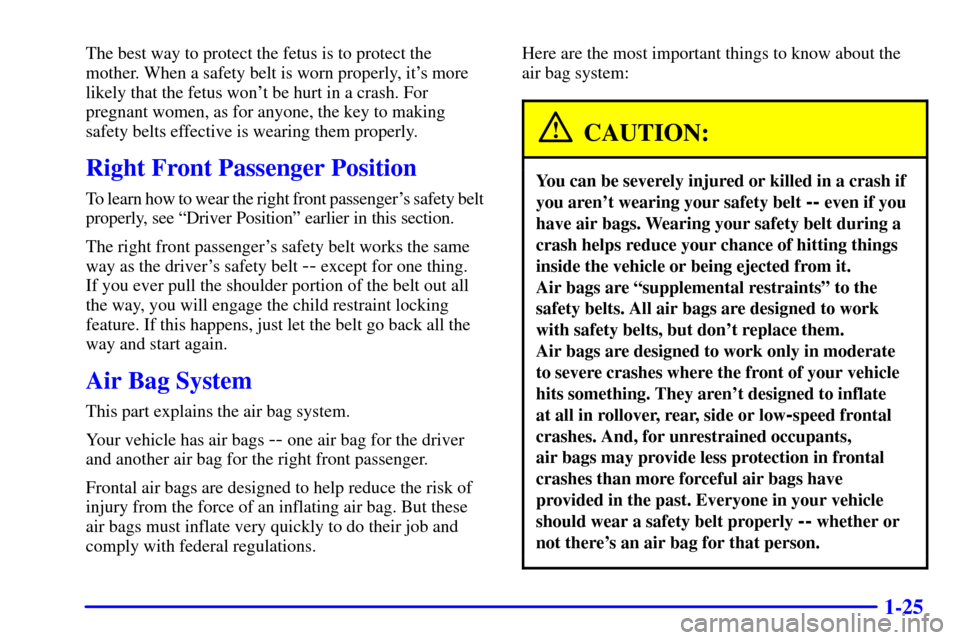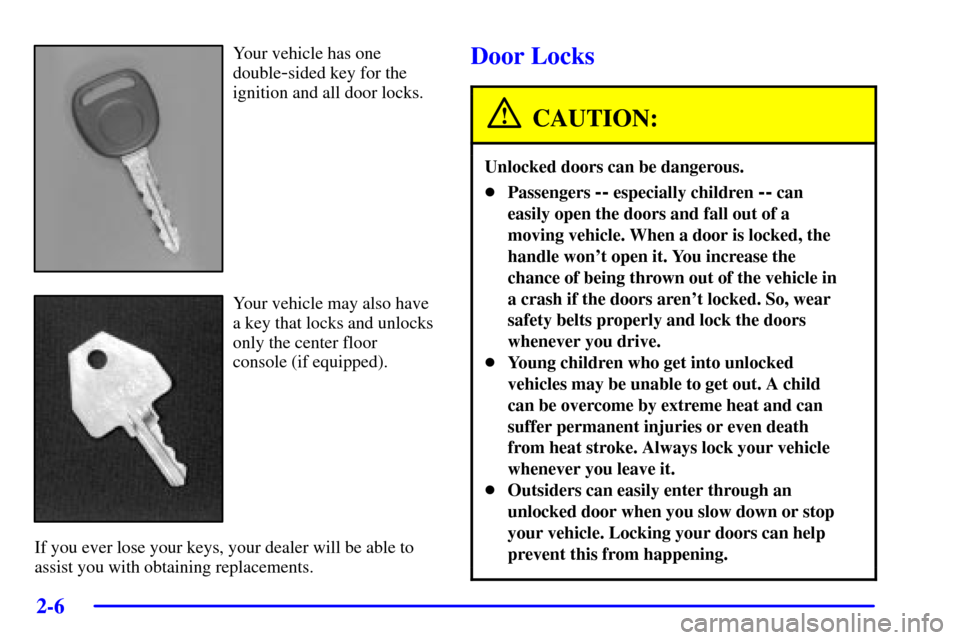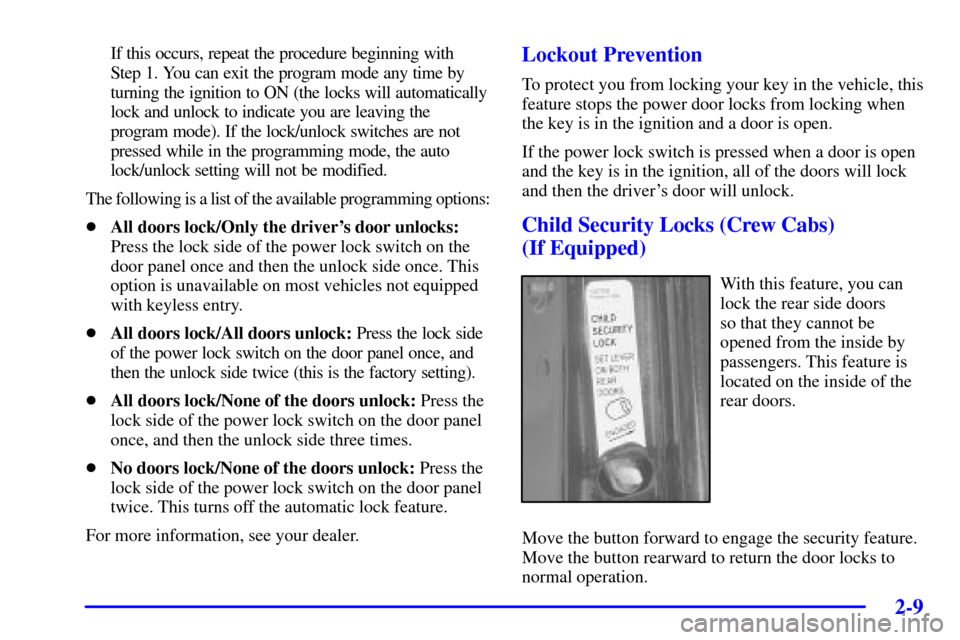Page 4 of 468
ii
Table of Contents
Windows
Keys and Door Locks
Keyless Entry System (If Equipped)
Tailgate
Automatic Transmission
Manual Transmission
Four-Wheel Drive Operation (If Equipped)
Parking Brake
Tilt Wheel (If Equipped)
Turn Signal/Multifunction LeverWindshield Wipers
Cruise Control
Exterior and Interior Lamps
Mirrors
Storage Compartments
Accessory Power Outlets
OnStar® System (Option)
Instrument Panel, Warning Lights and Gages
Message Center Seats and Seat Controls
Safety BeltsAir Bag System
Restraint Systems for Children
Section
1
Section
2
Seats and Restraint Systems
Features and Controls
Page 11 of 468

ix
For example,
these symbols
are used on an
original battery:
CAUTION
POSSIBLE
INJURY
PROTECT
EYES BY
SHIELDING
CAUSTIC
BATTERY
ACID COULD
CAUSE
BURNS
AVOID
SPARKS OR
FLAMES
SPARK OR
FLAME
COULD
EXPLODE
BATTERY
These symbols
are important for
you and your
passengers
whenever your
vehicle is driven:
CHILD
RESTRAINT
TOP STRAP
ANCHOR
DOOR LOCK
UNLOCK
FASTEN
SEAT
BELTS
POWER
WINDOW
AIR BAG
These symbols
have to do with
your lamps:
MASTER
LIGHTING
SWITCH
TURN
SIGNALS
PARKING
LAMPS
HAZARD
WARNING
FLASHER
DAYTIME
RUNNING
LAMPS
FOG LAMPS
These symbols
are on some of
your controls:
WINDSHIELD
WIPER
WINDSHIELD
WASHER
WINDSHIELD
DEFROSTER
REAR
WINDOW
DEFOGGER
VENTILATING
FAN
These symbols
are used on
warning and
indicator lights:
ENGINE
COOLANT
TEMP
BATTERY
CHARGING
SYSTEM
BRAKE
COOLANT
ENGINE OIL
PRESSURE
ANTI-LOCK
BRAKES
Here are some
other symbols
you may see:
FUSE
LIGHTER
HORN
FUEL
Vehicle Symbols
These are some of the symbols you may find on your vehicle. Also see ªWarning Lights and Gagesº in the Index.
Page 31 of 468

1-18
How to Wear Safety Belts Properly
Adults
This part is only for people of adult size.
Be aware that there are special things to know about
safety belts and children. And there are different
rules for smaller children and babies. If a child will be
riding in your vehicle, see the part of this manual called
ªChildren.º Follow those rules for everyone's protection.
First, you'll want to know which restraint systems your
vehicle has.
We'll start with the driver position.
Driver Position
This part describes the driver's restraint system.
Lap-Shoulder Belt
The driver has a lap-shoulder belt. Here's how to
wear it properly.
1. Close and lock the door.
2. Adjust the seat so you can sit up straight.
To see how, see ªSeatsº in the Index.
3. Pick up the latch plate and pull the belt across you.
Don't let it get twisted.
The shoulder belt may lock if you pull the belt across
you very quickly. If this happens, let the belt go back
slightly to unlock it. Then pull the belt across you
more slowly.
Page 38 of 468

1-25
The best way to protect the fetus is to protect the
mother. When a safety belt is worn properly, it's more
likely that the fetus won't be hurt in a crash. For
pregnant women, as for anyone, the key to making
safety belts effective is wearing them properly.
Right Front Passenger Position
To learn how to wear the right front passenger's safety belt
properly, see ªDriver Positionº earlier in this section.
The right front passenger's safety belt works the same
way as the driver's safety belt
-- except for one thing.
If you ever pull the shoulder portion of the belt out all
the way, you will engage the child restraint locking
feature. If this happens, just let the belt go back all the
way and start again.
Air Bag System
This part explains the air bag system.
Your vehicle has air bags
-- one air bag for the driver
and another air bag for the right front passenger.
Frontal air bags are designed to help reduce the risk of
injury from the force of an inflating air bag. But these
air bags must inflate very quickly to do their job and
comply with federal regulations.Here are the most important things to know about the
air bag system:
CAUTION:
You can be severely injured or killed in a crash if
you aren't wearing your safety belt
-- even if you
have air bags. Wearing your safety belt during a
crash helps reduce your chance of hitting things
inside the vehicle or being ejected from it.
Air bags are ªsupplemental restraintsº to the
safety belts. All air bags are designed to work
with safety belts, but don't replace them.
Air bags are designed to work only in moderate
to severe crashes where the front of your vehicle
hits something. They aren't designed to inflate
at all in rollover, rear, side or low
-speed frontal
crashes. And, for unrestrained occupants,
air bags may provide less protection in frontal
crashes than more forceful air bags have
provided in the past. Everyone in your vehicle
should wear a safety belt properly
-- whether or
not there's an air bag for that person.
Page 71 of 468
1-58
1. Put the restraint on the seat.
2. Pick up the latch plate, and run the lap and shoulder
portions of the vehicle's safety belt through or around
the restraint. The child restraint instructions will show
you how. If the shoulder belt goes in front of the
child's face or neck, put it behind the child restraint.
3. Buckle the belt. Make sure the release button is
positioned so you would be able to unbuckle the
safety belt quickly if you ever had to.
4. Pull the rest of the shoulder belt all the way out of
the retractor to set the lock.
Page 78 of 468
1-65
3. Pick up the latch plate, and run the lap and shoulder
portions of the vehicle's safety belt through or around
the restraint. The child restraint instructions will show
you how.
If the shoulder belt goes in front of the child's face
or neck, put it behind the child restraint.
4. Buckle the belt. Make sure the release button is
positioned so you would be able to unbuckle the
safety belt quickly if you ever had to.
5. Pull the rest of the shoulder belt all the way out of
the retractor to set the lock.
Page 89 of 468

2-6
Your vehicle has one
double
-sided key for the
ignition and all door locks.
Your vehicle may also have
a key that locks and unlocks
only the center floor
console (if equipped).
If you ever lose your keys, your dealer will be able to
assist you with obtaining replacements.
Door Locks
CAUTION:
Unlocked doors can be dangerous.
�Passengers -- especially children -- can
easily open the doors and fall out of a
moving vehicle. When a door is locked, the
handle won't open it. You increase the
chance of being thrown out of the vehicle in
a crash if the doors aren't locked. So, wear
safety belts properly and lock the doors
whenever you drive.
�Young children who get into unlocked
vehicles may be unable to get out. A child
can be overcome by extreme heat and can
suffer permanent injuries or even death
from heat stroke. Always lock your vehicle
whenever you leave it.
�Outsiders can easily enter through an
unlocked door when you slow down or stop
your vehicle. Locking your doors can help
prevent this from happening.
Page 92 of 468

2-9
If this occurs, repeat the procedure beginning with
Step 1. You can exit the program mode any time by
turning the ignition to ON (the locks will automatically
lock and unlock to indicate you are leaving the
program mode). If the lock/unlock switches are not
pressed while in the programming mode, the auto
lock/unlock setting will not be modified.
The following is a list of the available programming options:
�All doors lock/Only the driver's door unlocks:
Press the lock side of the power lock switch on the
door panel once and then the unlock side once. This
option is unavailable on most vehicles not equipped
with keyless entry.
�All doors lock/All doors unlock: Press the lock side
of the power lock switch on the door panel once, and
then the unlock side twice (this is the factory setting).
�All doors lock/None of the doors unlock: Press the
lock side of the power lock switch on the door panel
once, and then the unlock side three times.
�No doors lock/None of the doors unlock: Press the
lock side of the power lock switch on the door panel
twice. This turns off the automatic lock feature.
For more information, see your dealer.Lockout Prevention
To protect you from locking your key in the vehicle, this
feature stops the power door locks from locking when
the key is in the ignition and a door is open.
If the power lock switch is pressed when a door is open
and the key is in the ignition, all of the doors will lock
and then the driver's door will unlock.
Child Security Locks (Crew Cabs)
(If Equipped)
With this feature, you can
lock the rear side doors
so that they cannot be
opened from the inside by
passengers. This feature is
located on the inside of the
rear doors.
Move the button forward to engage the security feature.
Move the button rearward to return the door locks to
normal operation.